NEET Previous Year Questions (2014-2024): Wave Optics | Physics Class 12 PDF Download
2024
Q1: If the monochromatic source in Young's double slit experiment is replaced by white light, then(a) Interference pattern will disappear
(b) There will be a central dark fringe surrounded by a few coloured fringes
(c) There will be a central bright white fringe surrounded by a few coloured fringes
(d) All bright fringes will be of equal width [2024]
Ans: (c)
In Young’s double-slit experiment, if a monochromatic source is replaced by white light, which contains multiple wavelengths, the patterns observed on the screen will differ significantly.
First, remember that the pattern formed in the double-slit experiment consists of both bright and dark fringes due to constructive and destructive interference, respectively. The position and intensity of these fringes depend on the wavelength of the light used. For monochromatic light (light of a single wavelength), the interference pattern is stable, with bright and dark fringes evenly spaced. Each fringe is uniformly bright or dark.
When using white light, which is a combination of various wavelengths of light, each color, or each wavelength, forms its own interference pattern with slightly different fringe spacing. This occurs because the separation between fringes Δy is given by the formula:
Δy = λL / d
Where:
λ is the wavelength of light
L is the distance from the slits to the screen
d is the separation between the slits
Since different wavelengths have different values for λ, each color’s fringes will be at slightly different positions. The result is that near the center of the pattern, where there is the least path difference, all wavelengths constructively interfere to form a bright white central fringe. However, moving away from the center, the fringes start to show different colors as the path difference between the light from the two slits increases. This causes a dispersion of colors with different orders of fringes dominated by different colors. The constructive and destructive interference patterns of different wavelengths slightly offset one another.
Thus:
- Option A - "Interference pattern will disappear" is incorrect because the interference pattern does not disappear but changes due to the dispersion of colors.
- Option B - "There will be a central dark fringe surrounded by a few coloured fringes" is incorrect as the central fringe in the presence of white light is bright, not dark.
- Option C - "There will be a central bright white fringe surrounded by a few coloured fringes" is correct. This is because all the wavelengths interfere constructively at the center, creating a bright white fringe, succeeded by colored fringes due to the varying interference conditions for each wavelength.
- Option D - "All bright fringes will be of equal width" is incorrect. The width and spacing of the fringes vary by wavelength, so the interference pattern will not have uniform fringe widths.
Therefore, the correct answer is Option C: "There will be a central bright white fringe surrounded by a few coloured fringes."
Q2: An unpolarised light beam strikes a glass surface at Brewster's angle. Then
(a) The reflected light will be partially polarised.
(b) The refracted light will be completely polarised.
(c) Both the reflected and refracted light will be completely polarised.
(d) The reflected light will be completely polarised but the refracted light will be partially polarised. [2024]
Ans: (d) According to Brewster's law, reflected rays are completely polarized and refracted rays are partially polarized.
According to Brewster's law, reflected rays are completely polarized and refracted rays are partially polarized.
2022
Q.1. For Young’s double slit experiment, two statements are given below:Statement I: If screen is moved away from the plane of slits, angular separation of the fringes remains constant.
Statement II: If the monochromatic source is replaced by another monochromatic source of larger wavelength, the angular separation of fringes decreases.
In the light of the above statements, choose the correct answer from the options given below: (2022)
A: Both Statement I and Statement II are true.
B: Both Statement I and Statement II are false.
C: Statement I is true but Statement II is false.
D: Statement I is false but Statement II is true.
Ans: C
Solution: For YDSE, angular fringe width is given by α = λ/d
It does not depend on the distance of screen from the slit, so statement I is correct.
Angular fringe width ∝ λ
 angular separation of fringes increases
angular separation of fringes increasesSo, statement I is true and statement II is false.
Q.2. In a Young’s double slit experiment, a student observes 8 fringes in a certain segment of screen when a monochromatic light of 600 nm wavelength is used. If the wavelength of light is changed to 400 nm, then the number of fringes he would observe in the same region of the screen is (2022)
A: 8
B: 9
C: 12
D: 6
Ans: C
Solution:

2020
Q.3. Assume that light of wavelength 600 nm is coming from a star. The limit of resolution of telescope whose objective has a diameter of 2m is: (2020)
A: 7.32 × 10–7 rad
B: 6.00 × 10–7 rad
C: 3.66 × 10–7 rad
D: 1.83 × 10–7 rad
Ans: C
Solution:
Q.4. The Brewster’s angle ib for an interface should be : (2020)
A: 45° < ib < 90°
B: ib = 90°
C: 0° < ib < 30°
D: 30° < ib < 45°
Ans: A
Solution: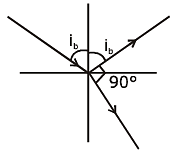
m = tan (ib)
ib = tan-1 (μ)
(μ > 1)
ib > 45
45 < ib < 90°
Q.5. In Young's double slit experiment, if the separation between coherent sources is halved and the distance of the screen from the coherent sources is doubled, then the fringe width becomes : (2020)
A: four times
B: one-fourth
C: double
D: half
Ans: A
Solution:
Fringewidth in YDSE is given by
2019
Q.6. In a double slit experiment, when light of wavelength 400 nm was used, the angular width of the first minima formed on a screen placed 1 m away, was found to be 0.2°. What will be the angular width of the first minima, if the entire experimental apparatus is immersed in water? (μwater = 4/3) (2019)
A: 0.266°
B: 0.15°
C: 0.05°
D: 0.1°
Ans: B
Solution:
In air angular fringe width
Angular fringe width in water

2018
Q.7. Unpolarised light is incident from air on a plane surface of a material of refractive index 'μ'. At a particular angle of incidence 'i', it is found that the reflected and refracted rays are perpendicular to each other. Which of the following options is correct for this situation ? (2018)
A: Reflected light is polarised with its electric vector parallel to the plane of incidence
B: Reflected light is polarised with its electric vector perpendicular to the plane of incidence
C:
D:
Ans: (b)
Solution:

Q.8. In Young's double slit experiment the separation between the slits is 2 mm, the wavelength λ of the light used is 5896 Å and distance D between the screen and slits is 100 cm. It is found that the angular width of the fringes is 0.20°. To increase the fringe angular width to 0.21° (with same λ and D) the separation between the slits needs to be changed to :- (2018)
A: 1.8 mm
B: 1.9 mm
C: 2.1 mm
D: 1.7 mm
Ans: B
Solution: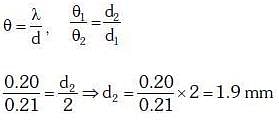
2017
Q.9. Young's double slit experiment is first performed in air and then in a medium other than air. It is found that 8th bright fringe in the medium lies where 5th dark fringe lies in air. The refractive index of the medium is nearly :- (2017)
A: 1.59
B: 1.69
C: 1.78
D: 1.25
Ans: C
Solution:
Fringe Width in a medium -
- where in
Since wavelength in a medium become
Fringe width in air 
Fringe width in any other medium 
According to question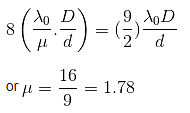
Q.10. Two Polaroids P1 and P2 are placed with their axis perpendicular to each other. Unpolarised light I0 is incident on P1 . A third polaroid P3 is kept in between P1 and P2 such that its axis makes an angle 45° with that of P1. The intensity of transmitted light through P2 is :- (2017)
A:

B:

C:

D:

Ans: B
Solution:
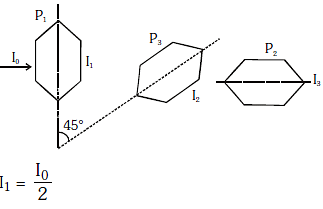
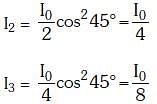
2016
Q.11. In a diffraction pattern due to a single slit of width 'a' the first minimum is observed at an angle 30º when light of wavelength 5000 Å is incident on the slit. The first secondary maximum is observed at an angle of : (2016)
A: sin-1 (3/4)
B: sin-1 (1/4)
C: sin-1 (2/3)
D: sin-1 (3/2)
Ans: A
Solution:
Given that, first minimum is observed at an angle of 30º in a diffraction pattern due to a single slit of width a.
i.e., n = 1, θ = 30º
According to the Bragg's law of diffraction,
For 1st secondary maxima,
Putting the value of a from Eqn. (i) to Eqn. (ii), we get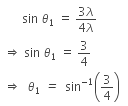
Q.12. The intensity at the maximum in Young's double slit experiment is I0. Distance between two slits is d = 5λ, where λ is the wavelength of light used is the experiment. What will be the intensity in front of one of the slits on the screen placed at a distance D = 10d ? (2016)
A: I0/2
B: I0
C: I0/4
D: 3I0/4
Ans: A
Solution:
Given,
Maximum intensity = Io
Distance between the slits, d = 5λ
Distance of screen from the slit, D = 10d
Using the formula,
Path difference, 
Here,
D = 10d = 50λ
So,
Corresponding phase difference will be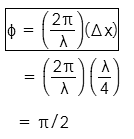



2015
Q.13. A radiation of energy = ‘E’ falls normally on a perfectly reflecting surface. The momentum transferred to the surface is (C = Velocity of light) : (2015)
A: E/C2
B: E/C
C: 2E/C
D: 2E/C2
Ans: C
Solution:
The radiation energy is given by
Initial momentum of the radiation is
The reflected momentum is
So, the change in momentum of light is
Thus, the momentum transferred to the surface is
Q.14. In a double slit experiment, the 2 slits are 1 mm apart and the screen is placed 1 m away. A monochromatic light of wavelength 500 nm is used. What will be the width of each slit for obtaining ten maxima of double slit within the central maxima of single slit pattern ? (2015)
A: 0.02 mm
B: 0.2 mm
C: 0.1 mm
D: 0.5 mm
Ans: B
Solution:
In a double slit experiment, the two slits are 1 mm apart.
d = 1 mm = 10-3 m.
The screen is placed at a distance D = 1 m away. Monochromatic light of wave length
λ = 500 nm = 5 x 10-7 m is used.
The distance between two successive maxima or two successive minima is
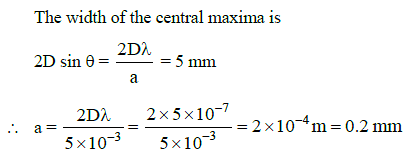
Q.15. For a parallel beam of monochromatic light of wavelength ‘λ’, diffraction is produced by a single slit whose width ‘a’ is of the order of the wavelength of the light. If ‘D’ is the distance of the screen from the slit, the width of the central maxima will be : (2015)
A: 2Da/λ
B: 2Dλ/a
C: Dλ/a
D: Da/λ
Ans: (b)
Solution:
For a parallel beam of monochromatic light of wavelength λ, diffraction is produced by a single slit whose width 'a' is of the order of the wavelength we have

where θ is the angle subtended by the first minima and the central maxima at the slit.

If x is the width of the central maxima, we have

where D is the distance of the screen from the slit
2014
Q.16. A beam of light of λ = 600 nm from a distant source falls on a single slit 1mm wide and the resulting diffraction pattern is observed on a screen 2m away. The distance between first dark fringes on either side of the central bright fringe is : (2014)
A: 2.4 cm
B: 2.4 mm
C: 1.2 cm
D: 1.2 mm
Ans: B
Solution: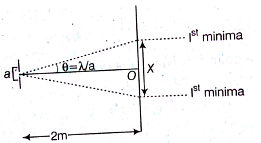
From the above figure,
For small θ and when θ is counted in rad, tan ≈ θ
So,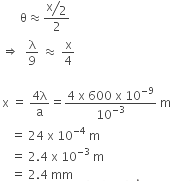
Q.17. In the Young’s double−slit experiment, the intensity of light at a point on the screen where the path difference is λ is K, (λ being the wave length of light used). The intensity at a point where the path difference is λ/4, will be : (2014)
A: K/2
B: Zero
C: K
D: K/4
Ans: A
Solution:
I = 4Io cos2(S/2)
4I0 = K
∵ δ = 2π if path different = λ
Phase difference when path difference = Δ/4 is equal to 

"There is no Question for NEET 2021"
|
97 videos|336 docs|104 tests
|

|
Explore Courses for NEET exam
|

|


















